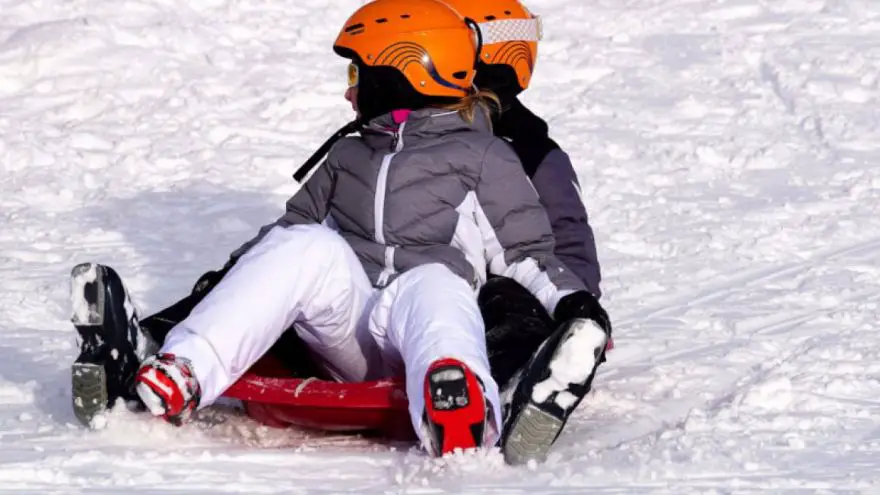Weird Winter Sports
 Weird Winter Sports
gearweare.net
Weird Winter Sports
gearweare.net
There are those who scoff at the idea of spending long periods of time outside for sport during the colder months. Despite the prevalence of wintertime recreational activities, exercising in the summer remains more popular. Practitioners of all winter sports, even the most popular, can therefore be lumped into a group known as “weirdos who don’t mind spending time in the cold.” Despite my own affinity towards chilly recreation, and my belief that there is no bad weather, only bad clothes, on 10? days I do get why many prefer summer.
Still, winter activities like skiing and snowboarding, ice skating, snowshoeing, and ice fishing are generally accepted as reasonable pass-times, even by those who let the mildest of chills drive them inside. Humans are nothing if not ingenious though, and over the years have come up with some winter sports that are truly weird. Some of these get their weirdness from their fringe nature, while others utilize equipment one would not usually associate with winter, sport, or both. Another sub-category is quite simply too dangerous and extreme to exist anywhere other than on the periphery.
Table of Contents
Skijoring
This sport got its start a few hundred years ago as a mode of transportation. Skijoring, pronounced ski-yoring, involved being pulled by a dog or a horse across snowy, icy ground while wearing skis. Essentially, this sport is cross-country skiing meets sled-dogs or horse racings. Competitions are races, sometimes with added jumps and other features that competitors must get over without losing their animal. Skijoring has appeared in the Olympics once, as an exhibition sport during the 1928 Winter Games in St. Moritz, Switzerland, but mainstream popularity didn’t catch on and the sport hasn’t been featured since.
Yukigassen
Yukigassen, pronounced you-key-goss-en, was invented in Japan and translates to “snow battle” in Japanese. Anyone who has either been in a snowball fight or played capture the flag may recognize this sport, which is a cross between the two. It is played with two team of seven, whose goal is to capture the other teams flag. As players move in on the flag they can eliminate those on the other team by hitting them with snow balls. Players wear helmets and face protection that give this already warlike sport even more of a special-ops feel.
Ski Ballet
Exactly what it sounds like, practitioners of ski ballet dance down the slopes to music while spinning, jumping, and flipping themselves over their poles. Events in this sport can be individual and pairs. Ski ballet has appeared in two Winter Olympics Games, in 1988 in Calgary, Canada, and again 1992, Alberville, France. Both times it was showcased as an exhibition sport, meaning winners received smaller metals, the metals didn’t count towards a county’s official metal count, and there was no guarantee that the sport would be showcased again. Low viewership that revealed a lack of popularity means that ski ballet hasn’t appeared in the Olympics since.
Shovel & Wok Racing
Shovel and wok racing both involve sliding down ice on untraditional objects, which is as good a reason as any other to list them together. Shovel racing was invented first, sometime in the 1970’s by ski lift operators who wanted to move more quickly down the hill. Since then it has become a full-blown sport, with competitions including an appearance in the X Games. Wok racing originated more recently. The idea was first proposed by a German TV hosts in the early 2000s as a joke, but the joke stuck, and now, like shovel racing, wok racing is featured in serious competition. Both sports may sound like a silly, but with racers consistently reaching speeds of over 100 miles per hour, they should be taken quite seriously. Competitors wear serious protective gear, and when injuries do occur they are usually quite serious.
Snowsurfing & Snow Kayaking
These two sports take vehicles that are typically used to travel across water and use them on snow. Snowsurfing utilizes an adapted windsurfing board, and harnesses the wind and snow to move practitioners over frozen lakes and down the side of mountains. The utilization of the wind helps increase speed, making it possible to even move uphill at times. Snowsurfing is quite dangerous, so if you are looking for a more approachable water sport adapted for snow, think about giving snow kayaking a try instead. In this sport, traditional kayaks are waxed up and sent careening down a snowy mountainside. Drivers use paddles to steer, further adding to the illusion that the snow is a river. Reaching speeds of up to 60 kilometers per hour, snow kayaking may technically be safer than snowsurfing, but only by a small margin, and both sports certainly require an equivalent amount of guts.
Winter Pentathlon
As the name indicates, the winter pentathlon involves five different elements: cross-country skiing, shooting, downhill skiing, fencing, and horse riding. This eclectic lineup of sports one needs to be skilled in to be competitive has pushed the winter pentathlon into obscurity. This event was featured as an exhibition sport during the 1948 Winter Olympic Games in St. Moritz, Switzerland, but like the other sports on this list that briefly made it to the Olympics, the winter pentathlon didn’t stick. However, the biathlon, which involves cross-country skiing and shooting, and the summer pentathlon, which includes swimming, shooting, running, fencing, and horse riding, are both popular Olympic sports.
Ice Cross Downhill
This sport was invented by the Red Bull team and is featured during the Crashed Ice event. Participants race across ice on skates, while also hurtling down a steep track that has plenty of features including jumps, rollers, and chicanes. The event is incredibly dangerous, so racers wear gear that more closely resembles ice hockey uniforms than what a typical speed skater would wear. This is not one to try at home.











